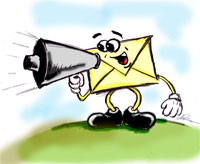As you know, ‘timing is everything’ in recruitment. Losing the perfect candidate because the decision to hire them was made 24 hours too late is terribly frustrating, especially if the position has been open for 3 months and you have spent hundreds of hours on it.
With recruitment always being a collaborative process, email is often the most common method for communicating with various characters involved (manager, external providers, supervisors not forgetting the candidate…). It allows you to address several people simultaneously (or to send them the message at the same time in any case) and in a simple manner.
The impact of an email however, remains weak in comparison to a telephone conversation or a meeting. To give your emails more weight here are a few tips:
As for any form of communication, a good email should:
- Have a catchy title
- Provide useful information
- Invite the recipient to reply.
When choosing the title ask yourself the following question: will the most sought after recipient on my list open my message on reading the subject? If the answer is yes there is a chance that others will open it too. Also, make the title as short as possible (1 word) and relevant to the message content. If the subject of the email is deciding to make an offer to a pre-selected candidate, choose ‘Offer Jean-Philippe’ or ‘Follow-up final interview Jean-Philippe.’
 Keep the body of the message simple, use short, straight to the point sentences. No more than 10 lines (signature included) in my opinion. If your message is more than 10 lines but it is all indispensable, choose another form of communication first (at least with certain people involved). If numerous details are necessary to the reader’s understanding, put them in an attachment. Even when you want to keep it short, it’s not forbidden to start with ‘Hello’ or ‘Dear colleagues.’
Keep the body of the message simple, use short, straight to the point sentences. No more than 10 lines (signature included) in my opinion. If your message is more than 10 lines but it is all indispensable, choose another form of communication first (at least with certain people involved). If numerous details are necessary to the reader’s understanding, put them in an attachment. Even when you want to keep it short, it’s not forbidden to start with ‘Hello’ or ‘Dear colleagues.’
The most effective way of obtaining a quick reply is to finish your message with an open question. If you use the MS outlook program, you can also resort to some tricks:
- Mail read: To be used in moderation, as the recipient can get the wrong impression of being spied on. On receiving your message, the recipient will in effect receive a notice informing them that they have successfully received your message by asking them if they wish to return this receipt to you. Even if they decide not to return the receipt, it can leave them thinking that you have also asked to receive a delivery notice (which does not require the recipient’s participation) and that you therefore formally expect a reply from them.
To accompany your message with a receipt or delivery notice, compose your message and go to ‘View’/’Option’ and check your choices in the ‘Voting and tracking button’ section.
- The vote button: In the same way, in Outlook your messages can be accompanied by a vote button in the form of yes/no, accept/reject or yes/no/maybe (not advised as the choice often falls on maybe). This option is good for saving time making decisions, for example, for fixing a meeting date (you send 3 emails to a list of recipients offering three different meeting dates with a yes/no vote and from the answers you determine the date which is most convenient for everybody.
To accompany your message with a vote button, compose your message then go to ‘View’/’Option’ and check the type of vote button in the ‘Voting and tracking button’ section.
- The deferred email: This allows you to prepare your email when it suits you (after an interview for example) and to keep it in the drafts until a time when most of the recipients will be in front of their screen (particularly useful for those who work with people in various time zones).
To defer your message, compose your message, go to ‘View’/ ‘Option’ and check ‘do not deliver until’ and then find out when is the best moment.
If on top of that you pay attention to your list of recipients (don’t forget to copy in a recipient of a certain status), your emails should attract! Happy emailing…